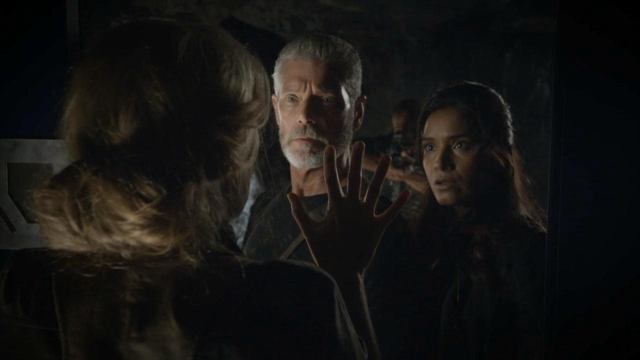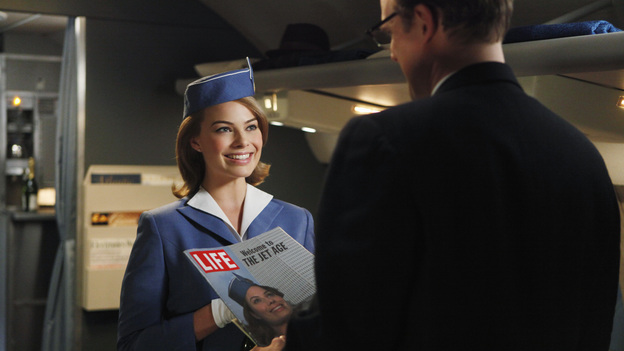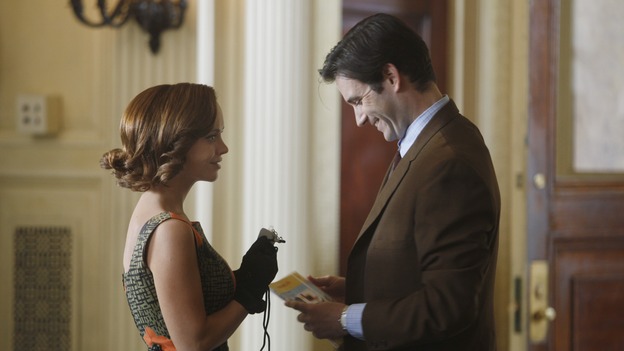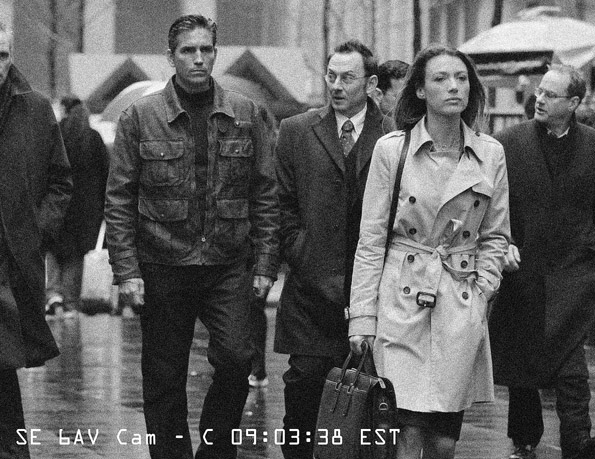TV Report Card: Terra Nova, Pan Am and Person of Interest
Back in the summer, I wrote a post where I listed which new Fall shows would take off, and which would be dead on arrival. At that point, all I could go on were cast lists, trailers and other associated buzz. Now that the season is several weeks in, I’m following up with a “report card” of sorts for three shows I’ve been watching: Terra Nova (Fox), Pan Am (ABC) and Person of Interest (CBS). Read on to find out how the shows are doing!
First up: a little explanation of what I’m basing these scores on. So far, I’ve watched the first three episodes of each show. To keep with the school metaphor, I’ll break away from the four-star scale and award each show a letter grade. I’ve spread the report card across three pages, so be sure to click through until the end..
Terra Nova (Mondays 8/7c):
I was impressed by Terra Nova when its premiere aired two weeks ago. I felt the show did a good job setting up its characters, and laid out some good groundwork for the rest of the season. Some of the dinosaur effects were admittedly low-budget, but they didn’t ruin the episode.
Three episodes in, and Terra Nova is working through some early-season hiccups. The second episode dealt with a swarm of angry pterosaurs attacking the Terra Nova settlement. I kind of hoped we wouldn’t see a major dinosaur-related plotline in the second episode, but the pterosaurs are a type of dinosaur we don’t see much in pop culture, so in a way, the story stayed alive.
The solution to the swarm was a bit of a wash-out, though: the scientists concoct a magic pheromone substance to lure the pterosaurs away. It was all too simple for me. Jim and Taylor load the barrel of spray onto a jeep and drive away from Terra Nova, leading the pterosaurs to a new breeding ground like a pair of prehistoric Pied Pipers.
What I especially didn’t like was the plotline (which continued in Episode 3) of Jim’s wife Elisabeth running into an old boyfriend named Malcolm in Terra Nova, who moved there during an earlier pilgrimage. Immediately, this morphed into a tired jealousy subplot. Jim feels sexually threatened by Malcolm, who happens to be the Chief Science Officer of the settlement. Cue awkward dialogue and forced drama.
Whenever the male lead's "dominance" is tested like this, it always feels stale. It’s hard to believe that a stable relationship like the one Jim and Elisabeth are shown to have would be suddenly threatened by an old friend. It only serves to make the characters feel like emotionally insecure teenagers.
Unfortunately, this concept persisted in Episode 3, with a memory-loss story that caused Elisabeth to forget who Jim is. Again, Malcolm was brought into play, and rather than create some funny banter between Jim and Malcolm, it just lacked credibility.
The “enemy” in Episode 3 was kind of uninspired, too. A memory-loss virus that eventually sends victims into a coma felt like it was recycled from the CW’s recently wrapped Superman show, Smallville. These kinds of self-contained conflicts have been used too much on other sci-fi shows, and I hope the writers don’t keep using them as the season goes on.
What I want to see from Terra Nova is more human-vs-human action – specifically, more clashes with the Sixers, the mysterious breakaway faction. I’d also like more character development for Jim and Elisabeth, beyond simple relationship material: let’s see what they were like as kids or something. The dinos and comic-book stories should wait until later in the show, after we know the characters and the world better.
For now, I’ll stick with Terra Nova and see where it goes. The series is still finding its groove – I just hope that groove stays away from the hokey storylines we see on low-budget sci-fi television.
Grade: C+
Keep reading to see the score for ABC’s Pan Am…
Pan Am (Sundays 10/9c):
I started watching this show yesterday so I could write this post, and I’m being drawn further in with each episode. If you’re unfamiliar, Pan Am is about a flight crew working for the titular airline in the early 60s, smack in the middle of the golden age of air travel. The stewardesses Maggie, Kate, Colette and Laura are the main ensemble cast, supported by the captain, Dean, and his first officer, Ted.
Right from the first trailer, Pan Am set itself up as ABC’s answer to Mad Men, one of my favourite shows. It depicts a glitzy and exciting vision of the 60s, but avoids the full-on grit and realism of Mad Men.
Notably, no character smokes on the show, which is attributed to the series appearing on the ABC network, subject to different content rules. There’s also far less drinking and sex, but whether these decisions harm Pan Am is a discussion for another post.
What I like about Pan Am is its focus on character. We start digging into who these stewardesses are from the opening episode: Maggie is headstrong and experienced, Kate is the black sheep of her family, Laura wants to see the world, and Colette is struggling with her memories of life in Nazi-occupied France.
The series incorporates a cool subplot: Kate has become involved with the American government as a junior spy, acting as a courier for sensitive materials and using her job as a Pan Am stewardess as a cover. The realm of Cold War espionage is woven into the show through Kate, which gives the show some real depth.
The show works best, I think, when the scenes during Pan Am flights are sparse. When we’re aboard the plane, establishing shots can only be rotating wide angles of the jet in flight, and the alternation between cabin interiors and plane exteriors can get a bit formulaic.
The most exciting stories happen on the ground, where we see the girls using their status as Pan Am stewardesses to get into all kinds of interesting situations, like a party for JFK in Berlin after his famous “Ich bin ein Berliner” speech. These intersections of history with the stories of the show are something that Mad Men does masterfully, and I’m curious to see how Pan Am will do it in future episodes.
So far, so good for Pan Am. It’s exceeded my expectations, especially considering the fate of NBC’s recently cancelled 60s drama The Playboy Club. Even though we’re getting a slightly sanitized version of the time period, Pan Am seems able to hold its own, even compared to the fantastic Mad Men.
Grade: A
Keep reading to see the score for CBS’s Person of Interest…
Person of Interest (Thursdays 9/8c):
Going into the Fall season, I was perhaps most excited for CBS’s Person of Interest, starring Michael Emerson and Jim Caviezel. Emerson (Ben Linus from Lost) plays an eccentric billionaire who recruits Caviezel’s character John Reese, an ex-CIA asset, to help him prevent murders.
Emerson’s character Mr. Finch does this with the help of a machine he designed for the government that is meant to identify and stop terrorist attacks. The machine is supposed to disregard all non-terrorist crimes, but this means that many violent acts are left unpunished.
Because the machine only prints out the social security numbers of the people who will be involved in violent crimes, Finch hires Reese to track the soon-to-be victims and perpetrators and prevent the crimes from happening.
I loved Emerson in Lost, and while his Mr. Finch portrayal is eerily similar to Ben Linus in the way he speaks and behaves, his motivations and backstory are unique and compelling. Finch’s guilt over the “irrelevant” people ignored by his machine is believable, and it’s fun to flash into his background for puzzle pieces about who he is.
Caviezel plays a fairly standard ex-CIA guy. He has a gravelly, monotone delivery that some might find funny, but I kind of like. The show writers are slowly building some humanity into Reese, though at the moment, he’s a bit of an invincible automaton, efficiently dispatching baddies and surviving countless brushes with death. I hope they can build on him as the show continues – the final scene in Episode 3 was a hint that the writers are working on it.
Some of the espionage tactics got sloppy in Episodes 2 and 3. While Reese can bug cellphones so he can overhear conversations, we often don’t see the act of him hacking the phone – it’s a bit implausible that he apparently bumps into every target or suspect to place the bug.
Reese’s interventions also stretch believability. He participates in shootouts and causes all kinds of car accidents, effortlessly avoiding the NYPD at every turn. I’m looking forward to future episodes when Reese has to escape situations using more than martial arts moves and a well-placed gunshot to the knee.
There are some elements of the editing in Person of Interest that I really like. The use of surveillance-camera footage as establishing shots is fresh, as are the flashbacks that are called up like they’re being retrieved from a database. It plays into the major theme of Person of Interest: that widespread information-gathering and surveillance is necessary to prevent future terrorist attacks.
The theme runs all through the show, popping up in frequent references to the September 11th attacks. Episode 3 also took on the global recession, telling the story of ex-soldiers who rob banks because there a few jobs available when they return from foreign deployments. Some of the social references feel a bit heavy-handed, but they help ground the high-calibre action of the show to real-world events.
Grade: B-
What do you think of the grades for these three shows? Have you been watching any of them, and have some thoughts of your own? Which other series should I cover in future “report card” posts? Share your reaction to Terra Nova, Pan Am and Person of Interest in the comments section, and check out some of my recent TV commentary:













